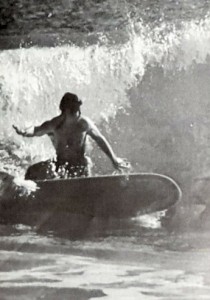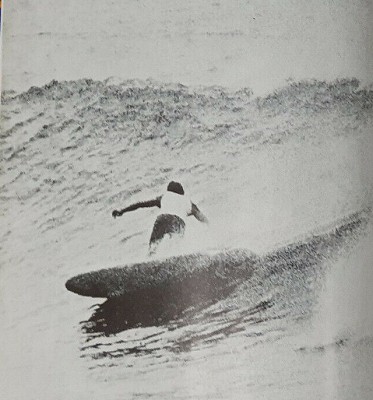surfresearch.com.au
 |
surfresearch.com.au
woodward : design retrospective,
1968
|
Greg Woodward : Design
Retrospective, 1964-1968.
Greg Woodward : WA (Design
Retrospective)
Surf International
Volume 1 Number 7, June 1968, pages
12
to15.
Introduction.
A highly
perceptive and informative Australian
design retrospective over the past five years, as seen by an
'outsider'
or average surfer.
The article demonstrates the dominance of Sydney
manufacturers in Australian
board design and illustrates how quickly developments transferred
to the
rest of the country.
Unfortunately, none of the accompanying photographs are captioned,
identifying the surfer.
Also in
this edition:
Bob McTavish : Rincon, pages 10 to 11.
John
Wiztig and Wayne Lynch : Australian
Titles, pages 20 to 25.
Page
12
WA
 Greg Woodward
Greg Woodward
|
Page
13
This
heart rending
trilogy plus one began as a chronology of Western
Australian surfing.
It
has developed
into a very, very rough outline of the progress in
Australia over the past
five years as seen by an 'outsider' or average
surfer.
In
this light
I make apologies to all those 'in the know' and
those who are too concerned
with surf- riding to bother writing crap like this.
A
STRINGERED
FLAT
BOTTOMED
SQUARE
TAILED
ROUND
RAILED
LONG
BOARD.
Two thousand miles
from the hub in the summer of '66, the sun was shining
on the fair city
of Perth and the small waves were lapping Scarboro
Beach.
I was
out there
tearing the place apart on my 10' 2" barge.
All
10' 2" of
which I was determined to purchase after reading a
certain hard cover surf
book written by a certain Scotsman as told by a
leading surf personality.
God only knows
how many years that board set my surfing career back.
It had beautifully
rounded rails that grooved into walls like runners on
curtains. |
When a cutback
was required you stuck your backside into the air and said
over three times,
"I am now going to cut back, I am now going, .," and so on and
so forth
and then floated off the wave.
When a nose ride happened along one experienced
the same sensation as being pushed down a flight of stairs.
After having
my head split open twice and carrying the bloody thing home in
100 plus
heat I was seriously considering taking up sex full time.
A STRINGERED
ROUND
BOTTOMED
SQUARE
TAILED
CHINED
RAILED
MEDIUM
BOARD.
Nat Young, fresh
from the World Championships, on an entirely new track
with his revolutionary
equipment and ideas, held a one man show at Scarboro
Beach and shook up
the locals considerably.
Although
the
surf was a sloppy three feet, Young astounded most
with his power turns
and spider scratching.
However
the over-riding
feature of his performance was the control he
exhibited in every aspect
of his surfing.
Control
in the
turn, on the nose, in the white water.
Page
14
Always
control,
and here he left the locals flat footed.
Young's
riding
was finesse and so it should have been.
The
dedication,
the purpose, practice and thought that had created a
World Champion were
evident here. |

|
Response to
Young's
visit was tremendous and very soon board shops were churning
out replicas
of the secret weapon he had dragged across a continent.
I was one of
the first to wreck the bank account to make the big purchase.
As I recall
the
first few months on that new board were utter frustration.
It was so
sensitive
to the slightest weight displacement and so fast out of a turn
that I kept
falling off the back.
Flotation was
the big issue.
Boards
were now
for surfing and not paddling.
Boards
9' 5"
by 2 1/2" !! with wafer thin rails that sliced into
the wave face but did
not groove.
Boards
that were
fast, hypersensitive in their response and gave ankle
control from the
nose.
In
fact a revelation
- a whole new experience.
A STRINGERLESS
FLAT
BOTTOMED
ROUND
TAILED
SOFT
CHINED RAILED
SHORT
BOARD.
Revolutionary
though it seemed at the time this was only the
beginning.
Farrelly
with
his stringerless and softer chines produced a board
that was different
again from Young's prototype.
Different
in
its freedom on the water surface.
With
its high
flotation this board seemed to slip over the water
whereas other boards
would track-in and groove.
|

|
 |
Came the 'Hot
Generation' and McTavish surfing sometimes as if glued to the
back of his
mini-board.
Bobbing up and down the wave face with short arcs, wide arcs,
and very few straight tracks.
Judging from the films and magazines and
McTavish's promotion of the short board it was he who broke
the straight
line.
Young, very
aggressive,
powered through sections using the shortest point from
collapsing section
to clear water, while McTavish avoided the mushy sections,
preferring to
fall with and skirt them.
All this,
culminating
with the Australian victory at Long Reef, brought about almost
national
acceptance of the short board.
Page 15
When the
short
boards first arrived in the west they appeared ugly, and
produced almost
the opposite of what was 'good surfing.'
Surfers were
using the things like water floats and after years of 'pure
trim' this
concept was a little difficult to swallow.
Yet the
months
passed and again the results began to pour in.
Such radical
improvements in performance by once mediocre surfers were
unbelievable.
It seemed
that
the path to progress was change and remarkably enough it was
always positive
change.
A
STRINGERLESS
VEE-BOTTOMED
PIN-TAILED
SOFT -RAILED
SHORT BOARD.
Last in
this account
but by no means final was the Australians returning from
Hawaii with their
vee-bottomed, adapted pin-tails.
Again it was
unbelievable how such small modifications in the bottom
contour and tail
shape could give such fantastic bullet turns and subsequent
acceleration;
how the pin-tail could affect the flow from section to
section; and how
the board as a whole was still one beautiful unit capable of
meeting all
conditions and turning in such exciting performances.
STRINGERLESS
DOME BASED
SAUCERS??
Still the
results
pour in and it seems the new word is 'flex', who knows?
What is
important
is that all steps forward be assimilated by the surfer so
that he may put
more into his surfing, and thereby gain a great deal more in
return.
What
happens now
is anybody's guess.
However, it
is
amazing to note the rapidity with which the good word has
spread and even
more amazing when one realises this has been achieved by the
efforts of
two or three individuals, who, through the medium of modern
mass communications,
have made a considerable dent in surfing history to date.
The full
impact
will be difficult to determine until the World Championships
in 1968, and
possibly later still.
Page 8
Nat Young
|

|
Surf International
Volume 1 Number 7
June 1968.
|

|

surfresearch.com.au
Geoff Cater (2010-2019) :
Greg Woodward
: WA (Design Retrospective), 1968.
http://www.surfresearch.com.au/1968_Woodward_WA_Design_Surf_Int_V1n7.html








